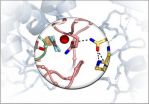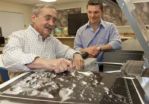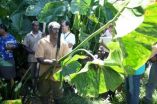(Press-News.org) (Embargoed) Scientists at the University of North Carolina at Chapel Hill School of Medicine have reported the exact molecular structure and mechanisms of a major cell signaling pathway that serves a broad range of functions in humans.
Up to half of drugs approved by the US Food and Drug Administration directly or indirectly target G protein-coupled receptors. These receptors, which are proteins that live in the outer membranes of cells, take molecular signals from outside the cell and convert them into responses within – and those responses help control behaviors as wide-ranging as cell growth, muscle contraction, platelet aggregation, sight, and smell.
Many G protein-coupled receptors engage two partners: the G protein, Gq, and an enzyme called phospholipase C, or PLC, to pass signals into the cell. Until now, it's been a mystery how this transfer of information occurs.
"We thought that to really understand how this signaling complex works, we had to go to the atomic level," said co-senior investigator Kendall Harden, PhD, Kenan Professor in the department of pharmacology at UNC.
The detailed atomic structure, to be published by the journal Science, within the Science Express web site, on Thursday October 21st 2010 , "is the culmination of 15 years of work, collaboration and a small but crucial bit of educated serendipity," Harden said.
For years, the group had been trying to understand how the G protein bound to PLC. The main challenge of solving any atomic structure is to get enough of the highly purified proteins. Then, it's a matter of setting up the right conditions — a trial-and-error process of tweaking the pH of the solution, the salts and numerous other variables — to get the proteins to form a crystal that can withstand the imaging process. Robots produce thousands of slightly different chemical conditions, each produced in volumes smaller than a pinhead, and automated imaging captures each reaction.
UNC research analyst Gary Waldo, the lead author of the paper, rifled through thousands of these imaged droplets before he found one that showed the PLC bound to Gq. Enzymes had eaten away part of the PLC molecule, and this missing piece allowed the PLC to properly crystallize with its partner.
The group then created the PLC with the exact same portion missing. It bound to the G protein and formed crystals overnight, said co-investigator John Sondek, PhD, co-senior investigator and professor of pharmacology and biochemistry and biophysics at UNC. Sondek and Harden are members of the UNC Lineberger Comprehensive Cancer Center.
Once they had the structure, the researchers were able to alter parts of the complex to see exactly how they interact and how the complex works to both turn on and turn off the signal. For example, three different areas of the PLC molecule come into contact with the G protein.
To better help understand the importance of the interaction, the researchers introduced a small mutation in part of the PLC molecule they hypothesized was important to shut off the signal at the cell membrane. Expressing this mutation in the PLC of eyes of flies, the group found that the signaling pathway in eyes exposed to light stay stuck in the 'on' position. "The flies can't see because they can't refresh the signal," Sondek said.
The group plans to carry more of the molecular work into mice and other animals. "It's already well known how important the signaling pathway is, Harden said. "but our new knowledge helps us see how G proteins and PLC work together to regulate, for example, the proliferation of cells, and how certain genetic mutations in these molecules may contribute to cancer."
The new findings will also allow scientists to understand how this signaling complex interacts with other molecules. The group will eventually be able to visualize this complex interaction in real time, and to disrupt it using small compounds.
Of course, new science generates many more questions, which Harden and Sondek will pursue. "You can't be anything other than ecstatic," Harden said.
INFORMATION:
Other UNC study co-authors include Tiffany Ricks, PhD; Stephanie Hicks, PhD; and Matthew Cheever, PhD. Additional co-authors were Takeharu Kawano and Kazuhito Tsuboi, University of Illinois; Xiaoyue Wang and Craig Montell , Johns Hopkins University; and Tohru Kozasa, University of Tokyo.
The research was supported by the National Institute of General Medical Sciences.
Study details molecular structure of major cell signaling pathway
2010-10-22
ELSE PRESS RELEASES FROM THIS DATE:
Risk gene for severe heart disease discovered
2010-10-22
Research led by Klaus Stark and Christian Hengstenberg of the University of Regensburg identified a common variant of the cardiovascular heat shock protein gene, HSPB7, which was found to increase risk for dilated cardiomyopathy by almost 50%. Their paper appears on October 28 in the open-access journal PLoS Genetics.
Per year, about 6 in 100,000 individuals develop dilated cardiomyopathy (DCM), with a higher prevalence in men. This disease is characterized by an enlarged, weakened heart, subsequently affecting the pumping capacity and often leading to chronic heart failure. ...
Mathematical model helps marathoners pace themselves to a strong finish
2010-10-22
CAMBRIDGE, Mass. -- Most marathon runners know they need to consume carbohydrates before and during a race, but many don't have a good fueling strategy. Now, one dedicated marathoner -- an MD/PhD student in the Harvard-MIT Division of Health Sciences and Technology -- has taken a more rigorous approach to calculating just how much carbohydrate a runner needs to fuel him or herself through 26.2 miles, and what pace that runner can reasonably expect to sustain.
The result is a new model, described in the Oct. 21 issue of the journal PLoS Computational Biology, which allows ...
NASA-engineered collision spills new Moon secrets
2010-10-22
VIDEO:
Peter Schultz and graduate student Brendan Hermalyn analyzed data from bits of the Moon’s surface kicked up by a NASA-engineered collision. They found unexpected complexity -- and traces of silver....
Click here for more information.
PROVIDENCE, R.I. [Brown University] — Scientists led by Brown University are offering the first detailed explanation of the crater formed when a NASA rocket slammed into the Moon last fall and information about the composition of the ...
Stanford study links cancer to loss of protein that hooks skin cells together
2010-10-22
STANFORD, Calif. — In a study to be published online Oct. 21 in PLoS Genetics, researchers at the Stanford University School of Medicine have implicated the lack of a protein important in hooking our skin cells together in the most common variety of skin cancer. Depletion of this protein, called Perp, could be an early indicator of skin cancer development, and could be useful for staging and establishing prognoses.
These findings' significance may extend beyond skin cancer, as Perp is found in the linings of many of our internal organs, where it plays the same role it ...
Protein injection shows promise in lowering elevated triglycerides
2010-10-22
Injecting a protein that helps break down triglycerides may someday help treat an inherited form of high triglycerides, according to a new study in Arteriosclerosis, Thrombosis, and Vascular Biology, an American Heart Association journal.
Triglyceride is a type of fat in the blood. Elevated levels in the blood — hypertriglyceridemia — have been linked to coronary artery disease.
In the study, researchers tested a new compound in mice genetically altered to be deficient in a protein called apolipoprotein (apo)A-V, which causes them to have high blood levels of triglycerides. ...
Treating metabolic syndrome, undergoing carotid angioplasty
2010-10-22
Treating metabolic syndrome and undergoing carotid angioplasty may prevent recurrent stroke or transient ischemic attack (TIA), according to revised American Heart Association/American Stroke Association guidelines.
Last updated in 2006, the evidence-based guidelines for doctors will be published in Stroke: Journal of the American Heart Association.
"Patients who've had a stroke or TIA are at highest risk for having another event," said Karen Furie, M.D., M.P.H., writing committee chair and stroke neurologist. "Since the last update, we've had results from several studies ...
Younger brains are easier to rewire
2010-10-22
CAMBRIDGE, Mass. - A new paper from MIT neuroscientists, in collaboration with Alvaro Pascual-Leone at Beth Israel Deaconess Medical Center, offers evidence that it is easier to rewire the brain early in life. The researchers found that a small part of the brain's visual cortex that processes motion became reorganized only in the brains of subjects who had been born blind, not those who became blind later in life.
The new findings, described in the Oct. 14 issue of the journal Current Biology, shed light on how the brain wires itself during the first few years of life, ...
Efforts underway to rescue vulnerable bananas, giant swamp taro, other Pacific Island crops
2010-10-22
INFORMATION:
The Global Crop Diversity Trust (www.croptrust.org)
The mission of the Trust is to ensure the conservation and availability of crop diversity for food security worldwide. Although crop diversity is fundamental to fighting hunger and to the very future of agriculture, funding is unreliable and diversity is being lost. The Trust is the only organization working worldwide to solve this problem. The Trust is providing support for the ongoing operations of the seed vault, as well as organizing and funding the preparation and shipment of seeds from developing ...
Nightshades' mating habits strike uneasy evolutionary balance
2010-10-22
Most flowering plants, equipped with both male and female sex organs, can fertilize themselves and procreate without the aid of a mate. But this may only present a short-term adaptive benefit, according to a team of researchers led by two University of Illinois at Chicago biologists, who report that long-term evolutionary survival of a species favors flowers that welcome pollen from another plant.
"We've shown that a strong, short-term advantage experienced by individuals that have sex with themselves can be offset by long-term advantages to plant species that strictly ...
Malarial mosquitoes are evolving into new species, say researchers
2010-10-22
Two strains of the type of mosquito responsible for the majority of malaria transmission in Africa have evolved such substantial genetic differences that they are becoming different species, according to researchers behind two new studies published today in the journal Science.
Over 200 million people globally are infected with malaria, according to the World Health Organisation, and the majority of these people are in Africa. Malaria kills one child every 30 seconds.
Today's international research effort, co-led by scientists from Imperial College London, looks at ...


